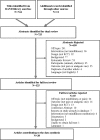Mindfulness Meditation for Chronic Pain: Systematic Review and Meta-analysis
- PMID: 27658913
- PMCID: PMC5368208
- DOI: 10.1007/s12160-016-9844-2
Mindfulness Meditation for Chronic Pain: Systematic Review and Meta-analysis
Abstract
Background: Chronic pain patients increasingly seek treatment through mindfulness meditation.
Purpose: This study aims to synthesize evidence on efficacy and safety of mindfulness meditation interventions for the treatment of chronic pain in adults.
Method: We conducted a systematic review on randomized controlled trials (RCTs) with meta-analyses using the Hartung-Knapp-Sidik-Jonkman method for random-effects models. Quality of evidence was assessed using the GRADE approach. Outcomes included pain, depression, quality of life, and analgesic use.
Results: Thirty-eight RCTs met inclusion criteria; seven reported on safety. We found low-quality evidence that mindfulness meditation is associated with a small decrease in pain compared with all types of controls in 30 RCTs. Statistically significant effects were also found for depression symptoms and quality of life.
Conclusions: While mindfulness meditation improves pain and depression symptoms and quality of life, additional well-designed, rigorous, and large-scale RCTs are needed to decisively provide estimates of the efficacy of mindfulness meditation for chronic pain.
Keywords: Chronic pain; Meditation; Mindfulness; Systematic review.
Conflict of interest statement
Funding and Disclaimer
The systematic review was sponsored by the Department of Defense Centers of Excellence for Psychological Health and Traumatic Brain Injury (contract number 14-539.2). The findings and conclusions in this manuscript are those of the authors and do not necessarily represent the views of the Department of Defense Centers of Excellence for Psychological Health and Traumatic Brain Injury.
Authors Statement of Conflict of Interest and Adherence to Ethical Standards Authors
Authors Hilton, Hempel, Ewing, Apaydin, Xenakis, Newberry, Colaiaco, Maher, Shanman, Sorbero, and Maglione declare that they have no conflict of interest. All procedures, including the informed consent process, were conducted in accordance with the ethical standards of the responsible committee on human experimentation (institutional and national) and with the Helsinki Declaration of 1975, as revised in 2000.
Figures
References
-
- Institute of Medicine: Relieving pain in America: A blueprint for transforming prevention, care, education, and research (report brief). www.iom.edu/relievingpain. 2011. - PubMed
-
- Department of Veterans Affairs Department of Defense: VA/DoD clinical practice guideline for management of opioid therapy for chronic pain. May 2010.
Publication types
MeSH terms
LinkOut - more resources
Full Text Sources
Other Literature Sources
Medical
Miscellaneous



